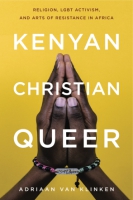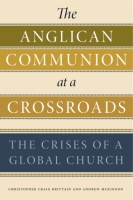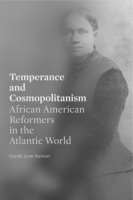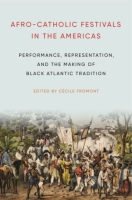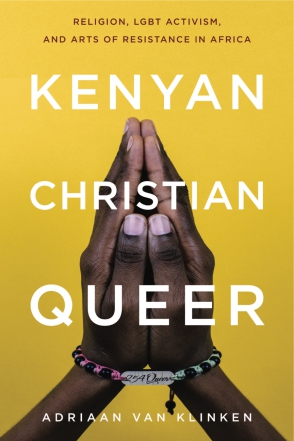
Kenyan, Christian, Queer
Religion, LGBT Activism, and Arts of Resistance in Africa
Adriaan van Klinken
Kenyan, Christian, Queer
Religion, LGBT Activism, and Arts of Resistance in Africa
Adriaan van Klinken
“In a fascinating dynamic that speaks to the passion and intimacy of the book, the author weaves his story with the stories of those whose lives he narrates. Thus, the author tells us about his connection to the communities he studied and how he is even assigned the position of an ambassador and advocate for these communities.”
- Media
- Description
- Reviews
- Bio
- Table of Contents
- Sample Chapters
- Subjects
Taking up the notion of “arts of resistance,” Kenyan, Christian, Queer presents four case studies of grassroots LGBT activism through artistic and creative expressions—including the literary and cultural work of Binyavanga Wainaina, the “Same Love” music video produced by gay gospel musician George Barasa, the Stories of Our Lives anthology project, and the LGBT-affirming Cosmopolitan Affirming Church. Through these case studies, Van Klinken demonstrates how Kenyan traditions, black African identities, and Christian beliefs and practices are being navigated, appropriated, and transformed in order to allow for queer Kenyan Christian imaginations.
Transdisciplinary in scope and poignantly intimate in tone, Kenyan, Christian, Queer opens up critical avenues for rethinking the nature and future of the relationship between Christianity and queer activism in Kenya and elsewhere in Africa.
“In a fascinating dynamic that speaks to the passion and intimacy of the book, the author weaves his story with the stories of those whose lives he narrates. Thus, the author tells us about his connection to the communities he studied and how he is even assigned the position of an ambassador and advocate for these communities.”
“This book evokes many feelings but also forces one to confront one’s own uninformed biases. It’s a good read for those who often shout the loudest, without sufficient understanding of LGBTI lives.”
“This book takes scholarship on religion and sexuality in a new direction towards a focus on queer activisms taking place in unlikely spaces in unexpected ways.”
“This book offers an important intervention in demonstrating that LGBT activism in Africa—indeed, in Kenya itself and even solely in Nairobi—is complex, varied, and both richer and more robust than it is typically made out to be. Van Klinken also persistently presses the important case that the ongoing resistance in queer studies circles to taking religion seriously not only is restrictive and irresponsible but actively excludes LGBT people of color and LGBT people in the global South.”
“The simple wish of the book is to serve as a counter narrative to the idea of African homophobia, an aim which is amply achieved. This book undoubtedly enriches the small but emerging area of sexual storytelling in global queer and religious studies, with its particular focus on questions of justice and the debates around human sexuality.”
“Van Klinken’s willingness to innovate through his embrace of ‘scavenger methodology’ and his close attention to sites of possibility, to prophetic vision, have produced a creative hybrid, a bricolage, that will stimulate further engagement between disparate fields, especially between queer studies and religious studies. The book also provides new perspectives in the burgeoning field of queer African studies.”
“Calling for a nuanced understanding of Christianity’s entanglements in queer politics, Adriaan van Klinken’s Kenyan, Christian, Queer (2019) challenges secularist ideologies that construe sexual emancipation and public religion as irreconcilable opposites. In detailing how this occurs, the book demonstrates a very keen dialectical imagination: it shows how a most outspoken Kenyan critic of religious homophobia borrows the very means and modes of charismatic leadership from Pentecostal evangelism, turning himself into a “queer prophet” of sorts; how a controversial queer rap video adopts and adapts stylistic elements from gospel performances, rendering “fluid boundaries between gospel and hip hop” (66); or how various queer subjects make religion central to their lives, by either keeping it separate from or reconciling it in various ways with their sexual selves.”
“The book is . . . graceful in its style and sensible approach to controversial issues in Nairobi and in scholarship. It is a pleasure to read; it manages to take readers by the hand and make them part of the ins and outs of queer lives, their artistic expressions, while at the same time it provides interesting insights in the uptake of theological treatises.”
“Van Klinken managed to do something that we, in African studies, are told isn’t possible. He took very real and very tangible complex sociocultural, religious, and theological critical theories of Kenya and framed them in a reimagined African setting where love was viable. A new standard has been set. In his own words, Van Klinken found a way for love to be “read as disruptive of Kenya’s dominant heteronormative culture” while at the same time platforming love as Kenyan LGBTQI communities’ most important asset.”
“Van Klinken has written a book that breaks new grounds through his passionate commitment and optimism, which allows him to give pride of place to the creativity and courage of lgbt activists in Kenya in a hostile context.”
“The hopeful nerve that striates the book is gripping and inspiring.”
“More than anything else, as I read this text, I found myself saying: This text delivers. It delivers stories of resilience and vulnerability. And it delivers these stories as invitations to otherwise possibilities. This text delivers these things to us. And, perhaps, in so doing, this text may offer us new resources for our own deliverance.”
“By foregrounding the researcher as an embodied being and by paying attention to the relational and indeed intimate and at times erotic dimensions of ethnographic research, van Klinken’s Kenyan, Christian, Queer unsettles traditional ways of knowing and offers us a deeply enfleshed lens wherein which the notion of being vulnerable emerges as a delicate embodied response to research relationships that generates emotional, erotic, and affective sentiments. Van Klinken shows us that when embodying the field, our bodies act as powerful mediators of relationships, of intimacy, and of the erotic—delicately navigating the complicated terrain between sameness and difference.”
“This is a book that celebrates interdisciplinarity and does so with a boldness that is chastened by an ethnographic openness.”
“The book is beautifully written and is a real “page-turner.” Page-turner is hardly a conventional epithet used to describe an academic book, but this book combines creative flair and authentic self-reflection, so skillfully and delightfully, with academic rigor and deep theoretical reflection, that it wholeheartedly deserves this description.”
“Kenyan, Christian, Queer . . . is not only eloquently written, but also pushes boundaries and allows us moments of intro- and retrospection, forcing us to both confront and rethink our personal and collective biases concerning ethnography, Christianity, Africa, homophobia, and sexualities to name but a few.”
“Van Klinken seeks to . . . combat essentializing narratives of “homophobic Africa” in the academy and the general public. In so doing, he utilizes an interdisciplinary set of methodological tools that draw from Queer Studies, Religious Studies, and African Studies, and also cuts across these disciplines to form a truly interdisciplinary, or possibly even transdisciplinary perspective.”
“With this book van Klinken makes a compelling, timely, and much-needed contribution to the study of religion, one that binds together important threads of discussions regarding diversity, queerness, and politics in global Africa and beyond.”
“Adriaan van Klinken’s Kenyan, Christian, Queer makes a timely and compelling contribution to scholarship and activism within and across queer, religious, and African studies. Situated at these theoretical intersections, the work sets out a case for how those on the sexual margins in Kenya are recrafting religious and political narratives in ways that upend the oppressive world views of Christian orthodoxies and their violent and exclusionary effects on queer life.”
“This book is a ground-breaking piece and addresses a controversial theme in the history of sexuality studies in Africa. As such, it will certainly provide momentum for local LGBT activists to break the silences surrounding sexuality and to ‘claim the ownership and control of their own bodies.’ It is committed to challenging normative concepts of culture and tradition that impinge on sexual and reproductive rights in Africa.”
“The theoretical and methodological contributions of this book are substantive. Van Klinken is widely and deeply read in African studies, religious studies, theological studies, queer studies, feminist studies, HIV studies, ethnographic studies, postcolonial studies, and decolonial studies. In a clear and accessible style, van Klinken brings these discourses into conversation, using ‘a scavenger methodology,’ using what is at hand in order (in the Foucauldian sense) to collaborate with African colleagues to forge the analytical resources we need to engage our own African realities.”
“Van Klinken has written a significant book on LGBTQ activism in Africa that presents a compelling ethnographic account of individual and social resistance, which the author analyzes with interdisciplinary tools, making clear that the questions of justice and belonging raised by LGBTQ persons invite readers to recognize our coevalness because the debate about sexuality is also a debate about our common and shared humanity. A must-read for those who want to understand the nuances of resistance and new approaches to the reformation of social beliefs today.”
“By showcasing a rich array of Kenyan queer creative practices, Adriaan van Klinken makes a compelling case for religion as a discursive site of African queer subjectivity, agency, and queer inventiveness that point to a nascent African queer theology. This book’s boundary-pushing methodology lends it a remarkable blend of integrity and risk that is generative for future reflections on ethnographic practice and the productive modes of addressing questions of positionality in research practice.”
“This book evokes many feelings but also forces one to confront one’s own uninformed biases. It’s a good read for those who often shout the loudest, without sufficient understanding of LGBTI lives.”
Adriaan van Klinken is Associate Professor of Religion and African Studies at the University of Leeds. He is the author of Transforming Masculinities in African Christianity: Gender Controversies in Times of AIDS and coeditor of several books, including Public Religion and the Politics of Homosexuality in Africa and Christianity and Controversies over Homosexuality in Contemporary Africa.
Contents
Preface
Acknowledgments
Introduction: From “African Homophobia” to Queer Arts of Resistance
1 | Kenyan Queer Critique of Christianity and
Homophobia
Interlude 1 Prophetess
2 | Kenyan Claim to Queer and Christian Love
Interlude 2 Bodywork
3 | Kenyan Queer Stories of Sexuality and Faith
Interlude 3 Positive
4 | Kenyan Queer Christian Community
Interlude 4 Ambassador
Conclusion
Notes
Bibliography
Index
Introduction
From “African Homophobia” to Queer Arts of Resistance
In July 2015, then U.S. president Barack Obama paid an official visit to Kenya. His visit coincided with my first research trip for the project that resulted in this book. In the weeks preceding Obama’s visit, I witnessed the mounting excitement. The reason for this euphoria was twofold. First, Obama was the first sitting American president ever to visit Kenya, which was seen as recognition of the country’s rising status as an economic and political power in East Africa, if not on the continent. Second, given Obama’s Kenyan ancestry, he was welcomed as a “son of Africa” returning to his ancestral home.
In addition to excitement, however, there also was public anxiety about the visit. This was partly about security risks—understandable in a country that has experienced terrorist attacks. But mainly it was about the question of gay rights, the fear being that Obama would advocate for the rights of sexual minorities. This fear was particularly pertinent because of the ruling of the U.S. Supreme Court, just a month earlier, in favor of equal marriage rights for same-sex couples. In the weeks between this ruling and Obama’s arrival, leading Kenyan politicians, including Deputy President William Ruto and National Assembly Majority Leader Aden Duale, spoke out publicly against homosexuality, and they called upon Obama not to raise the issue. Pressured by journalists, Kenyan president Uhuru Kenyatta stated a few days before the state visit that gay rights were “a non-issue for the people of this country” and were not on the agenda for the meeting with his U.S. counterpart. The White House press secretary, on the other hand, stated that “the president will not hesitate to make clear that the protection of basic universal human rights in Kenya is also a priority and consistent with the values that we hold dear here in the United States of America.” Unavoidably, during the joint press conference, the question of gay rights came up and the difference in opinion between the two presidents was exposed. Kenyatta repeated his statement that, “for Kenyans today, the issue of gay rights really is a non-issue,” while Obama underlined his belief “that the state should not discriminate against people on the basis of their sexual orientation.”
This incident can be seen as yet another example of the clash between African countries and “the West” about the human rights of sexual minorities. But there are some interesting twists in this particular controversy. One of them is that because of Obama’s Kenyan ancestry, his pro-gay argument could not be as easily dismissed as exogenous and imperialistic by Kenyan political leaders (as similar arguments by other Western leaders have been in the past). Another, more hilarious, twist was that a rather marginal Kenyan political party, the Republican Liberty Party, seized the controversy as an opportunity to promote itself, announcing a “peaceful procession” to protest Obama’s “open and aggressive support of homosexuality.” This received global headlines, specifically because the RLP said that the procession would be carried out by “approximately 5,000 naked men and women” so that Obama “could see and understand the difference between a man and a woman.” The march was supposed to commence from Freedom Corner in Uhuru Park in central Nairobi. On the day of the protest, July 22, I found my way to the park. I did not want to miss out on this paradoxical public performance of nudity that aimed to protect public morality. But there were no nude protesters. Apparently, the organizers had already reached their aim: they had received enormous media attention, and Kenyatta had been forced to declare publicly that Kenya was not going to recognize gay rights.
In a surprising turn of events, while walking through the park looking for nude protesters, I saw two young men seated on a bench adjacent to the Nyayo Monument. As I passed, they turned to look at me, and I glanced back. It felt like I was cruising in the park. I decided to take another path to get closer to them. As they kept stealing glances, one of them greeted me with an elongated “Hi,” and with a warm smile he invited me to sit down. In the conversation that unfolded, they initially were vague about what they were doing in the park. When I told them jokingly that I had come to see the nude protesters and was disappointed not to find a single one, they laughed and opened up. It turned out that they were part of a small group of gay men meeting in the park every week—not to cruise for sex, but to support one another in their entrepreneurial activities, for which they had set up a system of savings and loans. In fact, they were waiting for other group members to arrive, and they invited me to attend their meeting. One by one, other folks joined, till there were seven of us. The meeting was opened with prayer, after which the leader welcomed me and asked us to briefly introduce ourselves. This was followed by sharing and discussion, mainly about entrepreneurial activities that members were involved in and small business opportunities they had identified. Clearly, this was an economic empowerment group avant la lettre. It also was a social support group, as before, during, and after the meeting, members talked about their challenges and struggles. Moreover, although not a religious group as such, the men naturally opened the meeting with prayer, asking God to bless their deliberations, and they closed with an intercessory prayer for individual group members and friends. Out of sight of the media, these men gathered every week in a highly symbolic spot in Nairobi’s public space: the park of independence (Uhuru), under trees planted by political activist Wangari Maathai in an area she baptized “Freedom Corner” in opposition to the oppressive regime of Daniel arap Moi. The park is also “at the religious core of the capital,” as it is surrounded by various prominent church buildings of Kenya’s major Christian denominations.
It occurred to me that this small, informal support group of gay men was perhaps more significant than the nude mass protest that had received so much media attention. Whereas the protest was supposed to show Obama the difference between a man and a woman, this unpretentious group of gay men showed me the difference between publicly stirred up homophobia and the way in which queer folk go on with their daily lives. Their simple presence in the park challenged the dominant narrative, presented by Kenya’s political and religious elites, that homosexuality is “un-Kenyan” and that there is no place for gay people in the country. The natural way in which they prayed during their meeting and integrated faith into their group further challenged the popular narrative of homosexuality as being “un-Christian,” and of gay people as sinners removed from God.
This story illustrates the dynamics that this book seeks to explore: dynamics relating to the creative ways in which gay men and other lgbt (lesbian, gay, bisexual, and transgender) people in Kenya make themselves visible despite sociopolitical homophobia; the implicit and explicit ways in which they counter this homophobia and challenge popular religious and political narratives; the agential ways in which they negotiate the politics of religion, sexuality, and citizenship; and the subversive ways in which they mobilize and empower themselves, creating space in a society where their existence and rights are considered, at best, a non-issue. This book is particularly interested in the role of religious belief and practice in what I call Kenyan queer “arts of resistance,” and it presents four case studies that analyze how religion, specifically Christianity, is drawn upon in lgbt activism in contemporary Kenya.
Beyond “African Homophobia”
In the early twenty-first century, sub-Saharan Africa has become widely associated with homophobia. Admittedly, the idea of homosexuality as “un-African,” “unnatural,” and “un-Christian” was prevalent throughout the twentieth century, reinforced by European colonial administrators and Christian missionaries, and in recent decades by HIV-prevention strategies. Yet in the past twenty years, many African heads of state, politicians, legislators, and religious leaders have invested tremendous energies and resources in popularizing this belief, entrenching it among their populations, and making it a key issue in the politics of African authenticity, identity, and citizenship—a process that Patrick Awondo has described as the “politicization of homosexuality” in contemporary Africa. This has not been merely symbolic: public and political rhetoric against homosexuality has reinforced the experiences of social discrimination and marginalization of gay and lesbian people; existing colonial antisodomy laws were dusted off and implemented to prosecute people accused of same-sex activity; new antihomosexual legislation was debated in the parliaments of several countries and was signed into law in Uganda, Nigeria, and The Gambia. One consequence of this development was that Africa, in the Western media and public mind, has become almost synonymous with homophobia, as demonstrated, for instance, in the BBC documentary depicting Uganda—with its infamous Anti- Homosexuality Act, which caused an international outcry—as possibly “the world’s worst place to be gay.” Such depictions are problematic for various reasons: they tend to give an essentializing and homogenizing account of homophobia as an ahistorical phenomenon driven by African culture, religion, and morality; they reinforce the tradition of othering Africa as a backward and conservative continent, allowing the West to profile itself as liberal and progressive; they overlook the complex political economies and the dynamics of globalization and postcolonialism in which local expressions of sociopolitical homophobia in Africa are embedded; and they fail to grasp the complexity of developments on the ground, which often are more multifarious than they appear at first sight.
The emphasis on homophobia in Africa risks obscuring the other side of contemporary dynamics. Alongside waves of homophobia, but less well documented in Western media and scholarship, increasing levels of lesbian, gay, bisexual, and transgender (i for intersex is sometimes added to this acronym: lgbti) community organization, social mobilization, and political activism can be observed in different parts of the continent. Urban spaces and popular culture in particular appear to allow for significant levels of queer visibility. It has been observed that in Kinshasa, in the Democratic Republic of the Congo, “despite its often moralistic and sometimes violent messages, popular culture is itself always already queer,” while in Nairobi, it has been noted that “despite virulent attacks by the political and religious section of the country against queer sexual expression, there is a visible queer existence that is predicated on embodied lived experiences and spatial subjectivity.” Sokari Ekine captures these dynamics more generally when she writes, “Over the past 10 years, many African countries have witnessed the transformation of LGBTI Africans out of unseen closets into visible broken glass cabinets, and the replacement of silences by an active and assertive engagement with the state, civil society, queer communities and international NGOs.” This development has been informed by broader activism in the areas of HIV and AIDS, women’s rights, and human rights, as well as by international discourses of lgbt identities and rights. Various studies have begun to document and examine the forms and strategies adopted by lgbt activists fighting for sexual diversity, especially in the context of southern Africa but also in other parts of the continent. In these mostly social-scientific studies, the phrase “sexual diversity struggles” usually refers to “strategic efforts to defend gender and sexual dissidence and to promote laws and policies that affirm gender and sexual diversity.” Such efforts are typically concerned with social advocacy, legal support, political lobbying, and (inter)national networking, and are aimed at community building, creating public and political support, propagating gender and sexual minority rights as human rights, and changing current legislation and policies. Through these strategic efforts, African lgbt activists have made significant advances. For instance, several countries have now included sexual minorities in their governmental sexual health strategies (specifically, HIV treatment); in 2015–16, the High Courts of Botswana and Kenya affirmed the freedom of association for lgbt advocacy groups and instructed the government to allow the registration of these groups as NGOs; in 2015, Mozambique officially decriminalized same-sex practices; in 2014, the African Commission on Human and Peoples’ Rights adopted a resolution calling on African states to end the violence and human rights violations against people on the basis of their sexual orientation or gender identity. These developments provide grounds for realistic optimism about the struggle for sexual diversity in sub-Saharan Africa. (Excerpt ends here)
Mailing List
Subscribe to our mailing list and be notified about new titles, journals and catalogs.
